Tomato pinworm: biology and control strategies for greenhouse tomato crops
Learn about the host plants, damage, life history, stages and control strategies for tomato pinworm for greenhouse tomatoes.
Introduction
The tomato pinworm (TPW) [Keiferia lycopersicella (Walsingham)] is primarily a pest in tropical and subtropical areas of the world. In the United States, it has been reported in several southern states such as California and Florida. Outside of the continental U.S., it has also been reported in places including Hawaii, Haiti, Mexico, Peru, Cuba, and the West Indies. Its first incidence in Canada was reported in 1946. Its most recent occurrence in greenhouse tomatoes in Ontario was during 1991, and it has been observed in a few operations every year since that time.
Host Plants
Solanaceous crops such as tomato, potato, and eggplant are the preferred host plants of TPW. Other solanaceous species such as pepper and tobacco do not favour development of TPW. Solanaceous weeds, such as horsenettle (Solanum carolinense L.) may serve as secondary hosts.
Description of Damage
The tomato pinworm attacks both the leaves and fruits of tomato. Tunnelling or mining by larvae in the leaves is the most common type of injury. Initially, the mine is long and narrow (Figure 1), but it later widens to become blotch-shaped. Older larvae may fold the leaf over itself, or knit 2 leaves together, between which they continue to feed, causing large blotches (Figure 2). In severe infestations, all leaves on a plant are attacked giving the crop a burnt appearance (Figure 3). More direct damage is caused to the crop when the older larvae may penetrate nearby fruits by burrowing under the calyx into the fruit. Very small pinholes are left at the points of entry, which are often marked by the presence of a small amount frass or droppings (Figure 4). Points of entry under the calyx are inconspicuous and can easily be overlooked during packing. Larvae may also bore into the sides of tomato fruits in heavily-infested crops.
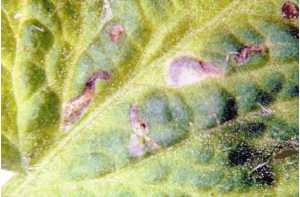
Figure 1. Larval mines.
Life History and Habits
The TPW passes through 4 stages (egg, larva, pupa and adult), and completes its life cycle in 26 days at 24-26°C, and 100 days at 10-13°C. The TPW is reported to be unable to survive the winter outdoors in Canada. However, they may be able to survive in crop debris left in the field or in other protected locations.
The newly-hatched larva moves about on the surface of the leaf for a short while until it finds a suitable place to enter the leaf. Then it eats its way into the leaf between the upper and lower leaf surfaces. The larva feeds within the mine until about half-grown, then emerges and may fold the leaf onto itself, or join 2 leaves by means of threads produced from its mouth. Here, the larva continues to feed between the leaf surfaces and forms large blotch mines. When fruits are present, larvae may enter fruits instead of folding the leaves. The number of larvae that enter fruits increases as the population density increases. The fully-grown larvae usually lower themselves by a thread to the ground to pupate, but pupation can also occur in leaf folds and fruits. The adults emerge from the pupal cells, mate, lay eggs and repeat the cycle. Mating occurs within 24-48 hours after emergence and most eggs are laid within a few days after emergence. The adults hide during the day and may fly erratically for short distances when leaves closest to the ground are disturbed. Flight and egg-laying usually begin at twilight and continue through the night if the temperature is above 16°C.
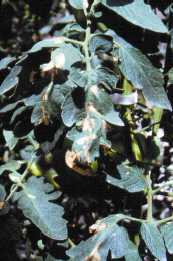
Figure 2. Blotches caused by the tomato pinworm.
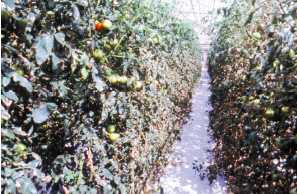
Figure 3. Infestations give crop burnt appearance.
Description of Stages
Egg
Eggs are laid scattered, or in small groups of 3-7, mainly on the upper leaves, and on both upper and lower leaf surfaces (Figure 5). The egg is oval in shape and very tiny (approximately 0.4 mm long). Its colour is pearly white at first, and then becomes pale yellow before hatching. The egg stage lasts from four to eight days at 22-24°C.
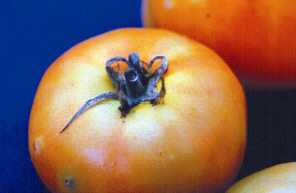
Figure 4. Small pinholes.
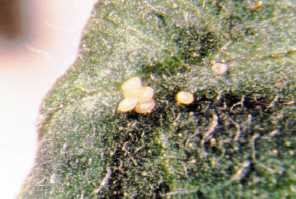
Figure 5. Eggs.
Larva
The larva molts 4 times. The newly-hatched larva is tiny (about 0.7 mm long), with a black or dark brown head capsule, and a cream-colour body. The fully-grown larva is 6-8 mm long, and has brownish to purplish markings along the body (Figure 6). Tomato pinworm larvae are characteristically very active and wriggle when touched. The larval stage lasts 10 days at 24-26°C.
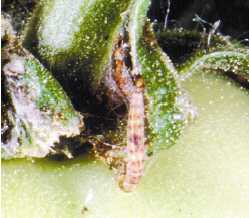
Figure 6. Larval stage.
Pupa
Pupation takes place within a loosely-spun cocoon in several possible locations including under debris on the ground, just under the soil surface, within the folds of leaves, on strings supporting tomato plants, or, rarely, in the fruits. The pupa is spindle-shaped; greenish at first, but soon changes to a dark chestnut brown colour (Figure 7). The pupal stage lasts 8-20 days depending on temperature.
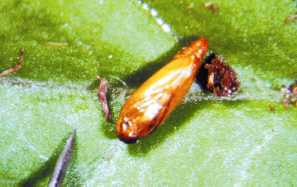
Figure 7. Pupal stage.
Adult
The adult resembles a clothes moth in size and colour. It is greyish-brown in colour and is 6-8 mm long (Figure 8). Adults live for about 7-9 days at 24-26°C, and for about 23 days at 13°C.
Control Strategies
Use of a combination of techniques is the best approach for managing TPW. Such techniques are as follows:
- Monitoring is key to detecting initial populations and preventing any build-up. This is most efficiently done by weekly inspection of pheromone traps that are placed in the greenhouse throughout the season to detect male adults. Place traps at the same height as the tops of the plants (Figure 9). Note that the pheromone lures placed in the traps must be replaced regularly according to the manufacturer's instructions.
- Sanitation - Thorough clean up of an infested crop is essential to preventing, or at least minimizing, carryover of populations to the next crop. Ensure that all crop debris is properly destroyed by burning or burying deeply. Adults cannot emerge normally if the pupal stages are buried at least 7-9 cm in the soil. See Sanitation Recommendations for Greenhouse Crops, OMAFRA Factsheet Order No. 94-029.
- Physical Hand Removal - By regularly inspecting the crop from the very start, and hand removing and destroying infested leaves, a build-up in a population could be prevented or at least minimized.
- Disinfest Crates - Ensure crates or boxes are properly disinfested before moving them from one operation to another. Adults, infested leaves, or fruits resting in crates can serve as a source of infestation.
- Biological Control - Studies at the Greenhouse and Processing Crops Research Centre in Harrow, Ontario, indicate that some Trichogramma species (Figure 10) hold promise as a biological control agent for TPW, but should be integrated with other control options.
- Mating Disruption - Slow release of the TPW sex pheromone into the atmosphere serves to confuse male TPW in their search for female TPW. This confusion results in the disruption of mating. When TPW populations in a greenhouse are low, and when there are no neighbouring sources of infestation, use of mating disruption is effective in suppressing populations of TPW.
- Light traps - Tomato pinworm adults are attracted to lights and commercially-available light-traps can assist in reducing adult populations (Figure 11).
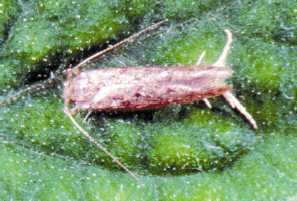
Figure 8. Adult.
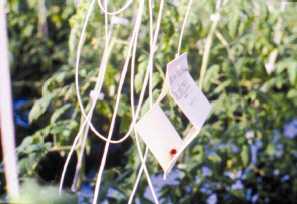
Figure 9. Traps.
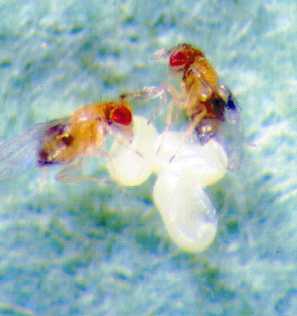
Figure 10. Trichogramma species.
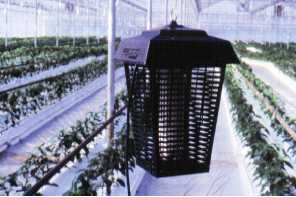
Figure 11. Light traps.
Summary
The tomato pinworm (TPW) [Keiferia lycopersicella (Walsingham)] is primarily a pest in tropical and subtropical areas of the world.Its first incidence in Canada was reported in 1946. Its most recent occurrence in greenhouse tomatoes in Ontario was during 1991, and it has been observed in a few operations every year since that time.
References
Diseases and Pests of Vegetable Crops in Canada. Eds. R.J. Howard, J. A. Garland and W. L. Seaman. 1994. The Canadian Phytopathological Society.
Evaluation Of Commercially-Produced Trichogramma Spp. (Hymenoptera: Trichogrammatidae) For Control Of Tomato Pinworm, Keiferia Lycopersicella (Walsingham) (Lepidoptera: Gelechiidae) On Greenhouse Tomatoes. Shipp, J. L., K Wang, & G. Ferguson. 1998. Can. Ent.: (submitted)
Incidence Of Tomato Pinworm, Keiferia Lycopersicella (Walsingham) (Lepidoptera: Gelechiidae) On Greenhouse Tomato In Southern Ontario And Its Control Using Mating Disruption. Wang, K, G. Ferguson, & J. L. Shipp. 1998. Proc. Ent. Soc. Ont.: (In Press)
Life History And Control Of The Tomato Pinworm. Elmore, J. C. & A. F. Howland. 1943. U. S. Dept. Agr. Tech. Bull. 841.
The Tomato Pinworm. Neiswander, R. B. 1950. Ohio Agr. Exp. Sta., Wooster, Ohio Research Bull. 702.
The Tomato Pinworm. Thomas, C. A. 1936. (Gnorimoschema lycopersicella Busck). Pa. Ag. Expt. Sta. Bull. 337.